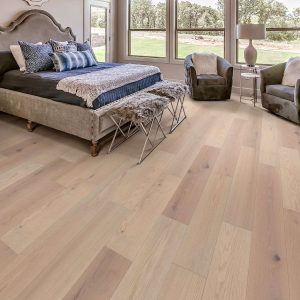Engineered oak floor is a modern alternative to traditional solid hardwood, combining the natural beauty of oak with advanced structural stability. Its layered construction makes it more resistant to moisture and temperature changes, making it suitable for a wide range of interiors. Whether you’re remodeling a family home or outfitting a commercial space, engineered oak offers both style and practicality.

Understanding Engineered Oak Construction
The core difference between engineered and solid oak flooring lies in how the planks are built. Engineered oak consists of a top layer of real oak bonded to multiple layers of plywood or high-density fiberboard.
Wear Layer
The wear layer is the top surface of engineered oak flooring, made of genuine oak. This layer determines the floor’s appearance and how many times it can be sanded and refinished. Thicker wear layers allow for more refinishing and longer lifespan.
Core and Base Layers
Beneath the oak veneer are cross-laminated layers that provide strength and help prevent warping. This multi-layer structure adds dimensional stability, which is especially beneficial in areas with fluctuating humidity or underfloor heating systems.
Types of Engineered Oak Flooring
Engineered oak floors come in various finishes, grades, and installation formats to meet different design and technical needs.
Pre-Finished vs. Unfinished
Pre-finished planks come with factory-applied coatings that are more durable than site-applied finishes. Unfinished planks allow for custom staining and finishing after installation.
Click-Lock vs. Tongue-and-Groove
Click-lock engineered oak is popular for DIY projects and floating floor installations. Tongue-and-groove planks require glue or nails and are better for permanent, stable installations.
Installation and Subfloor Compatibility
Engineered oak flooring is known for its versatility and can be installed over various subfloors, including concrete, plywood, and radiant heat systems.
Floating Installation
This method involves locking the planks together without attaching them to the subfloor. It allows the floor to expand and contract freely and is easy to replace or remove.
Glue-Down and Nail-Down Methods
These traditional installation techniques offer a more solid feel underfoot and reduce sound transfer. They are commonly used in high-traffic or commercial areas.
Visual and Functional Benefits
Engineered oak floors retain the rich character of natural oak while offering practical advantages for modern living.
Aesthetic Versatility
With a wide selection of stains, finishes, and plank sizes, engineered oak can match styles from rustic farmhouse to urban minimalism. Wire-brushed or hand-scraped finishes add texture and hide minor imperfections.
Resistance to Environmental Stress
The layered structure of engineered oak reduces expansion and contraction due to temperature and humidity. It performs better than solid wood in basements, kitchens, and other moisture-prone areas.
Maintenance and Longevity
Maintaining engineered oak flooring is simple and helps extend its life span.
Cleaning Practices
Use a microfiber mop or soft-bristle broom for daily cleaning. Avoid excessive water and opt for wood-specific cleaners. Keep mats at entrances to minimize grit and debris.
Refinishing and Repairs
Engineered oak with a thicker wear layer can be sanded and refinished, though not as many times as solid oak. For minor scratches, touch-up kits and repair pens can restore the finish without replacing planks.




